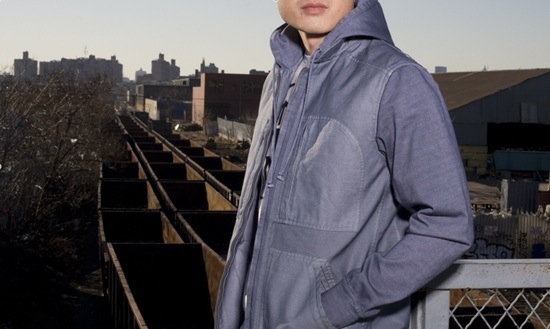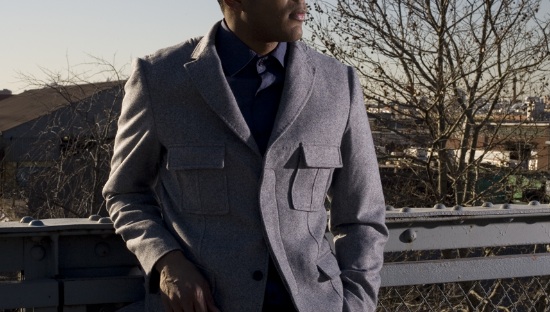SpearTalks: Luke McCann for Mottainai

You know, as a resident of Boulder, CO (a place that, for those unfamiliar, holds the earth in higher regard than 102% of the rest of the world) I shouldn't be saying this. Progress is progress, as they say, and of all things to rip on, things that treat Mother Nature with respect should be far from the top of the list (and if you feel the need to rip on me in recompense for this, please comment).
However, I have to say it, and here it is: Eco-style, thanks to the prevailing hype of its prefix, has had the opportunity to suck much worse than other areas of fashion. Attention to detail, structure, tailoring "“ vanities, really, when all you need to move units is organic cotton, perpetuated by a sort of user-generated laziness that buys anything that promises to stop global warming.
Well, wake up eco-fashionistas; your golden age is almost over, and we're welcoming your newest competitors with arms wide open. First on our list of new thrills: Mottainai, an NYC-born, Mother-loving label whose designs are as mindful as the materials used to create them.
Joshspear.com: The word "mottainai" has a really interesting meaning "“ can you tell us about it?
Luke McCann: Sure. "Mottainai," in its most basic form, means “what a waste,” or, “it's too valuable to waste.” In Japan, it is used in everyday conversations and embedded in folktales. There's a story in Japan about the Mottainai Ghost that will come for you if you waste something.
Think of it as when you see someone throwing away something perfectly useful, like food (you better eat all that!). The idea behind it is that a lot of people worked hard to bring that food (or in our case, clothes) to you, and in return you should be thankful and appreciative for what you were given, and use it to its fullest.
JS: How did Mottainai come about?
LM: Well, back in school (FIT), Rob, Tim, and I met, and after seeing how young designers were birdfed and exploited by design companies and agencies, we decided that we would do our own thing once we graduated. We had an idea/concept of what we wanted to do, but didn’t have a name for the brand. I was visiting my neighbor Minako Yoshino (a master sculptor/painter whose work has been featured at the United Nations, Moma, and NY Times) one evening, and he mentioned the word “mottainai." I talked about how wasteful the clothing business was, and the word stuck. We decided to run with it!
JS: What is your personal fashion background?
LM: Well, way back yonder, while I was growing up in Alabama and Mississippi, my mother taught, amongst other things, theatre arts. I helped her go to Salvation Armys, second hand stores, fabric stores, and garage sales to scout fabric and pieces for potential costumes. I also had three older brothers, so I was always taking their clothes and styling. Fast forward to Portland, Oregon, where in 2002 my brother Joe and I had a production company that put on various musical productions for artists like Too Short, Ludacris, LTJ Bukem, Kool Keith and DJ Qbert. I bought a silkscreen press in Seattle, taught myself how to use it, and started selling them at my shows and out of my trunk. I started to take it seriously when I applied to FIT to study menswear. I graduated last year – Class President 2007! – and am lucky to be working with not only my friends but with the right people. We're focused and highly motivated, but at the same time not too serious. We joke and play pranks on each other often.

JS: Mottainai has a pretty distinct look "“ clean seams, a modernized military feel, subdued colors "“ what am I missing?
LM: Thanks, we put a lot of care and detail into our pieces. They grow on you like a classic album or movie. We take inspiration from everything; the post-industrial environment we live in, to things we find while visiting archives or studying time period clothing.
But you are missing the understated elegance we hide in each piece. The level of craftsmanship is pretty intense, as we source and manufacture alongside some of the best (it rhymes with Nelmet Dang). We want to make clothes for a feeling or a mood so they last longer than “a made-up season” that is always changing.
JS: Your designs also have a Japanese vibe "“ not traditionally speaking, but in terms of what has been going on there, fashion-wise, in the past few years. Is that a valid evaluation?
LM:
That is a shockingly accurate evaluation – I am very impressed with these questions. As a matter of fact, we sourced 85% of our fabrics from Japan this season, leaving the trims and some shirting from Switzerland and Italy. We also are engaged with how detailed and precise the Japanese are when it comes to EVERYTHING! That motivates us to think beyond our first idea and reach for something very special.
JS: What kind of materials are you working with this season, and what makes them sustainable?
Well, it just so happens that 80% of the collection is organic and 100% incorporates all natural plant and vegetable dyes. The funny thing is, we never planned it this way; we simply were led by our eyes and gut feeling to go with the chosen fabrics. Never did we set out to use all organic fabrics, but it just so happened that the slub cotton jersey from Portugal for our tees was organic, as was the woven shirting from the northeast coast of Italy. The mill we work with in the Okayama prefecture of Japan has had a rich history of balancing modern and eco-friendly fabrics since long before green was this popular. We use four different organic denims, with the best seller being the 18oz, all natural, rope dyed indigo. Yes, the indigo dye is actually made from a plant, and by one person who’s only job is to yield the truest dye man can make.

JS: That zip-up hoodie "“ it looks like it’s a mix of denim and some other materials "“ is hot. Who comes up with the designs for these beautiful pieces, and how long does it take to develop the perfect prototype/sample?
LM: Thanks! That is the Pria Hoody, and damn you're good. The denim body is actually called Cordura – a mix of nylon and cotton that's tougher than you – and we used a high-density doby fabric to make a stylized butterfly lining. I sourced the “jacket jersey” for the sleeves, cuffs, and hood from a mill in Italy that uses a special agent to prevent it from stretching. It feels like a sweatshirt jersey but will not budge, just like the Cordura body. And, I can’t forget the zinc dyecast RiRi zippers.
I’ll take the credit for this piece – I started the design last year in school, and actually showed a very sad prototype of it for my final garment project. It's funny you ask about this one, since it took the longest to develop. We have made at least six prototypes to take it where it is now. Usually it does not take that many samples, but this one had lots of challenges.
JS: What is the classic Mottainai consumer like?
LM: The classic Mottainai consumer is anyone with an open state of mind that listens to their intuition and is honest with themselves. Easier said than done, but Mottainai is for that young man in transition; the post-premium consumer who is beginning to dress for a developing, cosmopolitan lifestyle.
JS: As of very recently, sustainable clothing was still the sort of developing category where the best had yet to emerge. However, your line of clothing is indiscernible "“ and almost better looking "“ than many popular, less mindful brands out there today. That said, do you think there has been a trend in the sustainable industry to slack a bit on design?
LM: Indeed, I was just talking about that with a friend. If your going to design something and keep it green, you had better be able to incorporate great style, fit, and appeal into it. I think of it as hiding the medicine in some candy. The products must be equally or more flattering than conventional ones, or you’ll add to the misconception that only tree-huggers rocking Birkenstocks and hemp jeans are eco-chic. We want to show people, "Look, isn’t this nice? (sick!)" not, "Look, this is organic!" So we don’t really promote ourselves as an organic brand, rather an eco-friendly brand with a resourceful message and products to back it up.

JS: Your suits this season are incredible. When the time comes, where might our readers be able to find them?
LM: Thanks, that's Rob's and Tim’s work! For the denim suits we use Japanese (organic) supima cotton and then stonewash certain pieces. Then, we cut and sew them using hand-finishing details throughout the garments. All those hours in our tailoring classes may soon pay off… they will be available in August at select stores, including Bergdorf Goodman and Jeffrey in NYC, and American Rag in LA.
JS: Do you have any short or long term plans for the development of Mottainai? (Like… a women’s line, perhaps?)
LM: Yes, as a matter of fact we hope by 2010 to be selling a capsule women’s collection. It’s very resourceful since most of the fabric we use can be considered unisex. Plus, I think if we would have made women’s first, we would be retiring sooner, as you would not believe how many ladies have asked (or demanded) a women's line since January.
JS: Thanks so much Luke!
LM: No thank you! I appreciate your interest and it reinforces what we are working so hard for…:)
